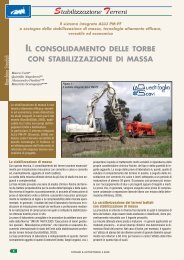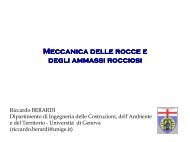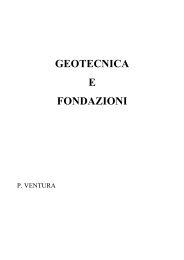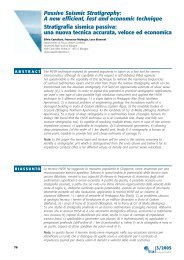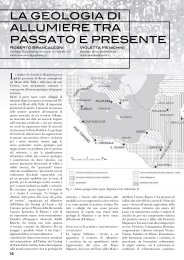Strutture di sostegno: pali e diaframmi - Geoplanning
Strutture di sostegno: pali e diaframmi - Geoplanning
Strutture di sostegno: pali e diaframmi - Geoplanning
Create successful ePaper yourself
Turn your PDF publications into a flip-book with our unique Google optimized e-Paper software.
SOLUZIONE DI SISTEMI NON LINEARI<br />
Molti problemi strutturali <strong>di</strong> tipo non lineare possono essere formulati sotto forma <strong>di</strong> sistema <strong>di</strong><br />
equazioni non lineari : L(u) = P<br />
La risoluzione <strong>di</strong> questi problemi può essere ottenuta con il metodo <strong>di</strong> Newton che permette <strong>di</strong><br />
trovare la soluzione come limite <strong>di</strong> una successione convergente <strong>di</strong> problemi lineari.<br />
Definita la funzione r(u) = L(u)-P il problema iniziale è equivalente a risolvere :<br />
r(u) = 0 dove r(u) è la funzione che descrive lo squilibrio (resto) ai no<strong>di</strong> della struttura.<br />
Sviluppando in serie la funzione si può scrivere :<br />
r(u+h)= r(u) + [∂ r(u) / ∂ u]*h<br />
Kt(u) = [∂ r(u) / ∂u] =[∂ L(u) / ∂ u] +[∂ P / ∂ u] = [ L(u) / u];<br />
Kt(u) è quin<strong>di</strong> il gra<strong>di</strong>ente della funzione L(u) ed ha il significato <strong>di</strong> essere la matrice<br />
tangente della struttura;<br />
r(u+h) = r(u)+Kt(u)*h=0<br />
h = -Kt -1 *r(u) = Kt(u) -1 *(P-L(u)) dove h è la correzione da apportare alla soluzione<br />
corrente<br />
Lo schema <strong>di</strong> iterazione sarà quin<strong>di</strong>:<br />
uo = Kt(0) -1 *P<br />
ui+1 = ui + Kt(ui ) -1 *(P-L(ui))<br />
Fig. 36 Soluzione <strong>di</strong> una equazione non lineare<br />
39



